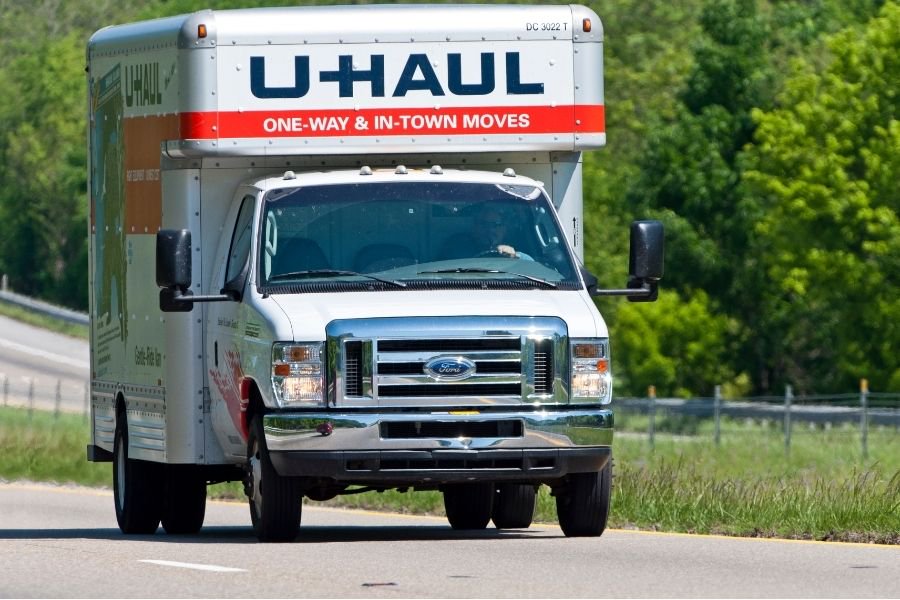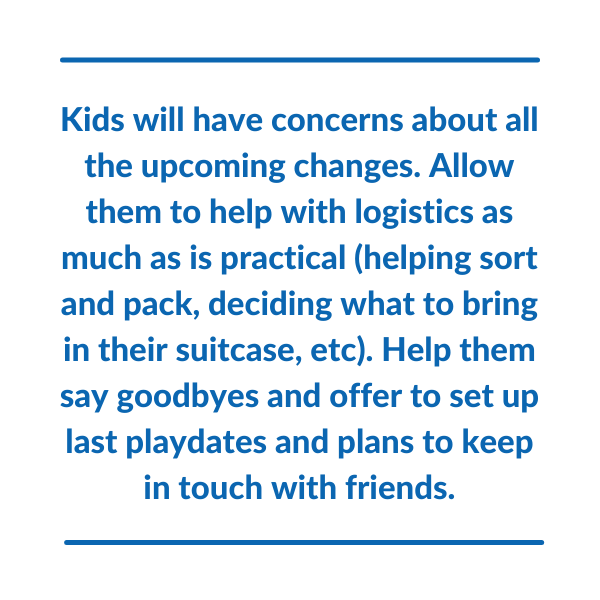.jpeg)
Photo from Canva
In this article:
Getting the notification that you have orders for a military move, or Permanent Change of Station (PCS), is undoubtedly an exciting moment. The prospect of new adventures, new surroundings, and new experiences awaits. However, it's completely natural to turn your attention first to the laundry list of tasks that must be accomplished before, during, and after the move.
Whether it’s your first move or your tenth, getting organized and knowing what to expect will help ease some of the stress of PCS.
What Kind of Move Is It: CONUS or OCONUS?
First things first, what type of move will you be making? Whether it's a CONUS (Continental U.S.) or an OCONUS (overseas) move, both involve planning, paperwork, and attention to detail. However, it's crucial to understand the differences between these two types of military moves, beyond the obvious aspect of location.
Overseas and CONUS moves share similarities in terms of the excitement and the need for organized preparation. In both cases, you'll be uprooting your life and starting anew in a different place. You'll need to sort through belongings, coordinate transportation, and notify various service providers about your change of address. Both moves also require you to prepare mentally and emotionally for the transition.
.png)
Photo from Canva
There are some major differences with an overseas military move:
Travel Documentation: For an overseas move, you'll need additional travel documentation beyond what's required for a stateside move. This may include passports, visas, and other entry permits for the military member and family members.
Customs and Import Restrictions: When moving overseas, you'll need to navigate customs and import regulations of the host country. Understanding what items are allowed, restricted, or prohibited in your destination country is crucial to avoid any legal issues during customs inspections.
Medical Clearance and Vaccinations: Overseas duty stations have specific health requirements for military personnel and their families. Before you move, you'll need to complete medical screenings and receive certain vaccinations to ensure you meet the health standards of the host country and to determine if the military can provide your family with the appropriate medical care after you arrive.
Cultural Differences and Language: Moving to an overseas location often means encountering new cultures, languages, and customs. Adapting to these cultural differences can be both exciting and challenging. Familiarizing yourself with the local language and customs can help ease the transition.
Schooling and Education Considerations: If you have children, researching and finding suitable schools that offer English language education or other language programs may be necessary if there are no schools on the installation. The education system in your new location may also be different from what you're accustomed to in the U.S.
Finding Housing: Finding suitable housing can be more complex in an overseas location. Military housing availability can vary, and there will be cultural differences in housing styles and amenities if you're renting or buying a home off base.
Transportation and Shipping: Coordinating the transportation of your belongings overseas involves additional logistical challenges, not to mention shipping your vehicle.
Military Spouse Employment: Opportunities will vary by overseas locations. Due to Status of Forces Agreements (SOFA), some locations do not allow military spouses to work off the installation, or “on the economy.” However, military spouses may be able to find employment on base with defense contractors, installation services, AAFES/commissary, or federal civil service. Learn more about military spouse employment overseas.
To help navigate an overseas move, military personnel or civilian travel offices provide counseling and checklists tailored to an OCONUS move. They’ll give you needed information about passports, travel arrangements, customs procedures, medical clearances, and other aspects unique to the overseas location where you're headed.
Two valuable resources to consult are the “It’s Your Move” document offered by TRANSCOM (U.S. Transportation Command) and "Plan My Move" from Military OneSource. You'll find guidance and checklists to ensure you don't overlook any crucial steps during your overseas move.

Will You Move Yourself?
If you’re moving in the continental United States (CONUS) rather than overseas (OCONUS), then you’ll need to decide whether you’ll use the military’s contracted movers or do it yourself and receive reimbursement later for moving costs by doing a Personally Procured Move (PPM) or DITY (“Do It Yourself”).
Note that a PPM can only be executed for a CONUS military move.
And then to make matters more complicated, there’s a "partial DITY" wherein you move part of your household goods yourself and are reimbursed for that portion. This is often accomplished by transporting part of your HHG in your own or rented vehicle(s).

Photo from Canva
- Make an appointment with your installation’s transportation office for approval for your PPM. You should be able to submit some of your paperwork online through DPS .
- Decide which rental equipment and packing materials you’ll need. Professional companies often offer partial moving assistance.
- Determine if temporary storage is required at either end of the move.
- Update your insurance policies. PPMs require up-to-date insurance policies for vehicles, trailers, and accident coverage.
- Get accurate vehicle weights, fully loaded and unloaded. This is crucial for reimbursement.
- Keep track of all necessary receipts to submit for reimbursement. Expenses that you'll be reimbursed for include payment for rental vehicles and packing materials, moving equipment such as hand trucks, gas and oil expenses, weight tickets and highway tolls.
Get Organized!
Create a PCS Binder
One of the keys to a successful military move is organization. Create a PCS binder and include any printed checklists, multiple copies of orders, travel documents, passports, Powers of Attorney, moving-related paperwork, medical and vaccine records, school records, housing info, contact details, moving company documents, and financial information.
Other paperwork that might need to be located here includes birth and marriage certificates and custody paperwork. Having all your necessary documents in one place will keep you on track and ensure nothing slips through the cracks.
Need more specific ideas for your PCS move checklists? See our free guide, Bloom Where PCS Plants You, for checklists for the weeks and days leading up to the move, moving week itself, and the days following.

Photo from Canva
Set Your Budget
"Well, at least the military moves you, and it won’t cost you anything!"
You've likely heard these words before, or you will in the future. And yes, you’ll receive travel and dislocation allowances, but you should also be prepared to cover extra expenses that could crop up, including:
- Maintenance and repairs if you’re selling your home or prepping it to rent
- Extra mortgage payments on said home if you’re unable to sell or rent it immediately
- Shipping an extra vehicle for an overseas move (the military will pay to move one vehicle overseas)
- Any extra travel costs: the military pays for a set number of days of temporary lodging whether the move is CONUS or OCONUS
- Costs for restocking food and other household items at your new home
This is an opportune time to look at your finances and reset your budget. Kate Horrell, military financial expert reminds us,
Get more helpful information for managing your finances during a PCS move:
back to top
Organize Your Belongings
Now's the time to get rid of items you haven’t used in a while, so they won’t count against your household goods weight allowance. When preparing for a military move, decluttering helps provide a smoother and more cost-effective relocation. Donate, hold a garage sale, and throw away the excess.
Some practical tips to declutter before your move:
Start early: Begin the decluttering process as soon as you know about your upcoming move. Unless you’re on short-notice orders, this should give you enough time to sort through your belongings methodically without feeling rushed.
Evaluate each item: Go through each room in your home and assess each item. Ask yourself if you’ve used it recently and if you're likely to use it in the future. If not, it might be time to part ways with it.
Donate: Items that are in good condition but no longer serve you can be donated to local charities, thrift stores, or organizations that support military families.
Hold a garage sale: Hosting a garage sale can be a rewarding way to both declutter and make some extra money.
Dispose of unusable items: Anything that is broken, damaged, or beyond repair should be discarded properly (think piles of worn-out plastic food containers). Recycle when possible.
Don't know where to begin?
From How to Declutter Before a PCS Move:
If you’re short on time or don’t have the energy to clean, sort, and disperse your items, you could consider using a company that hauls away junk for a fee. Some will trash unusable items and donate the rest. Don’t forget to ask for a military discount!
- 1-800-GOT-JUNK?
- College Hunks Hauling Junk & Moving
- Junk King
- Junkluggers
- JDog Junk Removal & Hauling
Keep your household goods weight allowance in mind: For military moves, there are weight limits on household goods. By decluttering and getting rid of items, you’ll reduce the weight of your belongings, which can lead to cost savings during the move, as you’re responsible to pay for moving anything that goes over your weight allowance.
Involve the family: Get your family involved in the decluttering process! This makes the task more manageable and lets kids help in some of the decision making.

Photo from Canva
More tips for organizing before the packers arrive:
- Remove batteries from electronics.
- Empty your gym locker and bring belongings home.
- Ask for items to be returned that were loaned to family and friends.
- Find a new home for your potted plants.
- If you have fish or a small animal such as a turtle or hamster that you’re not able to bring on this move, find a new owner well before moving day.
- Collect various owner's manuals and put them all in one large ziplock bag.
- Return library books and other materials on loan.
- Move professional items (“pro gear”) into one area, clearly identified. Don’t forget that military spouses may be eligible for allotted pro gear, too. (Up to 500 pounds of items needed for employment or community support activities. These items must be declared at origin.)
- Use zip ties to wrap cords of electronics. Tape matching cords to items. Keep remotes with items, batteries removed.
- Scrub clean and dry out any trash cans or recycling bins you plan to move.
- Check under beds and furniture for stray items.
In the day or two before the actual pack-out date, move these items to the space you’ve identified as the “do not pack” area. You may wish to designate a space or even a closet or bathroom:
- Remotes, cable boxes, modems, and routers from your local cable provider
- Luggage
- Clothes and toiletries
- Prescription drugs
- High value jewelry
- Cash
- Wallet or purse
- Keys
- Cell phones, laptops, and other electronics
- Chargers
- Firearms
- Trashcans or bins you don’t plan to move
- Supplies needed for cleaning before departure
- Dirty laundry, any wet cloths or towels
- Any personal items you don't want the movers to handle

Photo from Canva
Tips to Make Packing and Unpacking Easier
Strategic Packing of Beds and Furniture
- Have your beds packed last, as leaving them until the final moments might allow for an extra night's stay in your old place.
- Ask movers to leave out a chair or two until the last possible moment. Even if you’re only checking off the inventory sheet, you’ll want to sit down.
Efficient Set-Up at Your New Place
- Request that the movers prioritize assembling beds first upon arrival. This step ensures a comfortable space if you have small children needing naps and a restful first night in your new home.
- Label a designated box "unpack first" with items you'll need immediately at your new location, including essential items like bedding, towels, toilet paper, cleaning supplies, basic kitchen utensils, and any other necessities.
Ensuring Pet Safety
- Secure your pets in a safe and confined area during the move. Prevent the risk of accidental escape, even if it means using a kennel or a closed room.
- If possible, arrange for a friend to assist with pet sitting to keep pets comfortable or schedule a visit to doggie daycare.
Taking Care of Movers
- Offer sodas or at least water. It's common to provide lunch or order pizza for the moving crew.
- Offer tips at the end of the job if it’s customary in your area or you feel it’s warranted. Opinions are varied on this, but we’ve found after numerous moves that erring on the side of generosity seems to be a good policy.
Maintaining a Sense of Humor
- Embrace the inevitability of unexpected challenges during the move.
- Keep a positive outlook and be prepared to adapt to changing situations, because that is one given in military life.
- Remember that moving mishaps often turn into amusing stories in the long run. (Take a look at a few we’ve shared in You Gotta Laugh! Funny PCS Stories We Had to Share.)
Leaving Your Current Home
If you’re currently renting a home, notify your landlord of your upcoming move. But don’t do this until your orders are firm, as orders can change and you don’t want to be without a place to live.
If you’re living in military housing, check with the housing office ASAP for their move-out requirements.

Photo from Canva
If you own your home, begin preparing to put it on the market.
If you're a homeowner, you may be considering the question: Should I sell or rent out my home?
As noted in our resource PCS Ahead: Should I Rent or Sell My Home?, there are several reasons to rent out your home when you PCS:
- Home value: If you’ll lose money by selling it right now, you may want to rent it.
- Finances: You may find that you’re not financially able to sell at this time once you consider market conditions.
- Future plans: Do you plan on returning to this home? Will you buy another home?
Conversely, if you think selling your home might be your best option, consider the following as you place your home on the market.
- Housing trends: If the seller’s market in your area is favorable, you may choose to sell now rather than wait.
- Convenience: You’d rather not deal with the details of renting out a house.
- Your finances: You may not have the resources to provide upkeep on a home you’re not living in.
Of course, whatever you decide, you’ll want to list your home for sale or for rent on MilitaryByOwner in order to reach other families near your military installation. We offer help for each step of the home listing process, including ad packages (whether you’re a homeowner or real estate agent), yard signs, helpful home selling articles and resources, and frequently updated home selling blogs.
Quick & Easy Steps to Prepare for Your PCS Move gives you more details about preparing your house for sale or rent.
Research the New Location
Check the installation’s website and social media to learn more about the area, schools, amenities, and more. Read neighborhood reviews from other military families on Military Town Advisor to get an unfiltered look at the area and tips from those who've lived there.
Be sure to check out our base information pages to learn more details about your new duty station. Simply click the state, your base, then "more base housing details." You'll also find more base information and ideas of things to do for the whole family, on our frequently updated blog. Search by service branch, location, or city. Use the dropdown at the top of our blog page to see more options.
If you’re moving overseas, you'll be assigned an overseas sponsor who will be an invaluable resource regarding area-specific information.

Photo from Canva
Finding Your New Home
Networking is a crucial step for househunting, especially for military families. It can make the entire process smoother and more enjoyable. As soon as you know where you're moving, start reaching out to fellow military families. They are often more than happy to share their experiences and offer valuable insights into different duty stations and neighborhoods.
Check the gaining installation’s social media, and reach out to military spouse groups and friends of friends. Put the word out that you’re headed to a certain base, and you never know who can help!
From Everything You Need to Know for Your First PCS:
“People are very passionate about their housing experiences and especially love to share their best kept secrets. Along the way, keep an ear out for a veteran or military spouse real estate agent. If you make contact, they’ll probably already have a detailed strategy to help, whether buying or renting.”
We’ve compiled so many resources for would-be home buyers and renters to provide valuable information and guidance throughout the process. Start here.
Military Homebuyers:
Military Renters:
Preparing Kids for a Military Move
The Great School Search
Relocating with children brings its own set of considerations. Of course, one of the most significant factors influencing your choice of housing will be the available school options. Thankfully, there are so many research tools to make school shopping a bit easier for military families.
From School Quest and Great Schools to the Nation's Report Card and local school districts' websites, you can explore school rankings, testing scores, and state comparisons.

Photo from Canva
No matter what approach to education you decide on for your family— public, private or homeschooling—take a look at these resources to learn more about local schools.
- School Quest: Presented by the Military Child Education Coalition (MCEC), SchoolQuest helps parents of military-connected children manage the process of school transitions more effectively.
- Great Schools: Empowering parents with information.
- The Nation’s Report Card: Department of Education site. Compiles testing scores, rankings, and state comparisons.
- School Digger: K-12 performance data.
- State Boards of Education: The U.S. Department of Education has compiled a list and info for each state’s board of education.
- Local school districts: Check your local school district’s website for details about your specific locale.
- Private School Review: Find private schools by state, city, or address search. See rankings and even compare schools.
Ask for referrals. Some advice from A Pre-PCS School Checklist:
“Personal experiences and referrals from your friends and their friends are invaluable. Begin networking and exploring. Read blogs, Facebook pages, and neighborhood forums relevant to your next city. Post a general inquiry about what the schools are like in the area, and the answers will pour in. Moms and dads love to talk about their kids’ lives! Examine the general trend and ignore the worst and best comments to formulate an opinion based on the overall tone of the reviews.”
Help Your Military Kids Through a Move
Kids will have concerns about all the upcoming changes. Allow them to help with logistics as much as practical, for instance, helping sort and pack, deciding whether to sell or give away items they've outgrown or no longer need or want, choosing what to bring in their suitcase, etc. Recognize the value of involving your children in some of the practical aspects of the move.
Help your children navigate the emotional parts of moving, and facilitate opportunities to say goodbye to friends, neighbors, teachers, and coaches. Organize last playdates and encourage them to express their feelings.
Ask kids if they'd like your help in making plans to keep in touch with their friends, whether through texting, video calls, or social media, keeping valuable connections intact. And who knows? They just might be stationed near those friends again some day.

Balance positivity and processing. While maintaining a positive outlook about the move is important, it's equally important to give children the time and space to process their emotions. Acknowledge their concerns and listen to their thoughts. Let kids know that it's normal to feel a mix of excitement and apprehension, and reassure them that their feelings are valid.
Amidst all the changes, try to maintain familiar routines as much as possible. Consistency in bedtimes, naps, mealtime routines, and favorite activities can provide a sense of stability and security, especially during times of transition
Explore the military’s Youth Sponsorship Program and MCEC’s Student 2 Student Program. Military kids have the opportunity to connect with a peer before the move who can answer questions and then be a point of contact after they arrive.
Our resource, Avoid PCS Move Wipeout, also offers invaluable information about helping kids cope with a PCS move.
back to top
Military Spouse Employment and Connections
For military spouses, forging connections and building a support network is essential for both personal well-being and the successful navigation of a new military assignment. One of the remarkable aspects of military communities is how spouses often begin forming friendships and connections even before they arrive at their new duty station. Social media and mutual friends who've lived at the gaining installation can be invaluable resources.
Through social media, military spouses often find a virtual space where they can connect, share experiences, and get insights about upcoming assignments. If you’re a military spouse, this pre-arrival networking can help greatly with easing the transition process.
But real-life relationships are so important to acclimating to a new location. If you haven’t yet, push yourself to try out a local in-person spouses’ group. These groups offer a chance to meet other military spouses and establish friendships with those who are already well-versed in the dynamics of the area.
Whether it's a formal organization or an informal meetup, local spouses' groups can provide a supportive environment for socializing, sharing information, and creating lasting bonds. And they will know the best hole-in-the-wall local restaurants and don't-miss area nature trails!

Photo from Canva
The ongoing challenge of securing and maintaining employment is a common concern for military spouses. For starters, peruse MilitaryByOwner’s Ultimate Guide for Military Spouse Employment, where we've assembled the most pertinent information about federal agencies, nonprofits, remote work, and traditional companies that train and hire the military spouse community.
Nex, connect with programs and organizations like the following:
Plan for Moving Your Pets
Moving with pets brings another layer of complications. It can be stressful to move with pets! Military families love their animals and want to make sure they’re well-cared for during a PCS move. As a pet owner, there are some general tasks you can knock out or research well before moving day.
If you’re moving overseas, plan now for possible pet quarantines, veterinarian evaluations, and airline requirements. For help in preparing your pet for a move, reference our comprehensive resource, Moving with Your Pets, which includes information on prepping a pet for a PCS move, possible reimbursements for pet travel costs, options for transporting your pet, road tripping or flying with a pet, and pet boarding.

Photo from Canva
Whether your move will take you stateside or overseas, make arrangements well ahead of time for how you'll move your pet, pet boarding on both ends of the move if you'll need it, and pet-friendly temporary lodging and housing.
Depending where you're headed, a military transport flight for your pet might be a viable option, and there's also a chance you could qualify for pet relocation grants and reimbursement for quarantine fees. Get more details about these and other concerns in 6 Resources for a Military Move with Pets.
There’s so much to accomplish when it comes to a military move. However, a little bit of proactive planning can make a world of difference in reducing stress and ensuring a smoother transition. By taking the time to prepare in advance, you’ll equip yourself with the necessary knowledge and resources to tackle any challenges that lie ahead.
Download our complete set of PCS ebooks below for even more help, and best of luck with your upcoming move!
By Jen McDonald

back to top